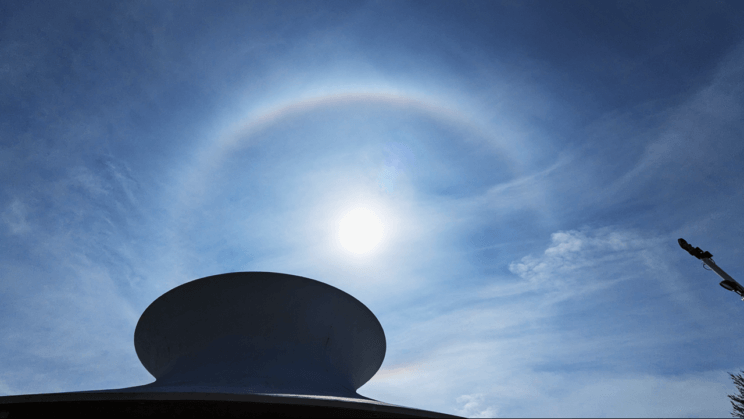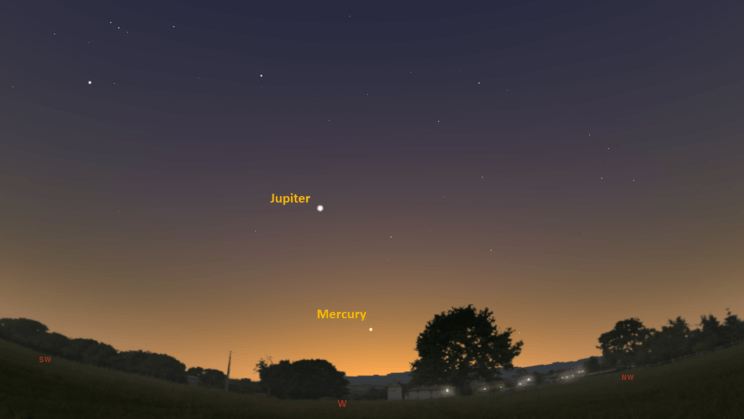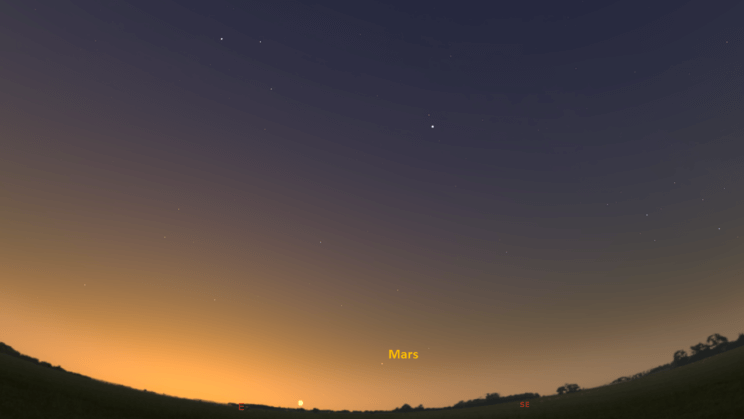This is the Saint Louis Science Center’s NIGHT SKY UPDATE for the week of Saturday, March 23, 2024.
Information updated weekly or as needed.
Times given as local St. Louis time this week will be in Central Daylight Time (CDT). For definitions of terminology used in the night sky update, click the highlighted text. If relying on times posted in Universal Time (UT), St. louis is -5 hours when CDT.
Join us for our next star party, Friday, April 5, 2024, held in association with the St. Louis Astronomical Society. For details, see the information at the bottom of this page or visit https://www.slsc.org/explore/mcdonnell-planetarium/public-telescope-viewings/
Observing Highlight of the Week

The oval shaped ice halo visible in this image is called a circumscribed halo. The are produced as light passes through pencil shaped ice crystals in the atmosphere. This halo was seen outside the McDonnell Planetarium on March 22, 2024. Image credit: Eric Gustafson.
On March 22, 2024, I stepped outside of the planetarium to check on the weather. Turns out it was a good timing as there was an ice halo visible, I hadn’t seen before. The halo was a circumscribed halo which like other ice halos is caused by ice crystals in the atmosphere.
The appearance of circumscribed halos depends on having the right clouds and what the Sun’s altitude is. You should look for circumscribed halos when high altitude cirrus and cirrostratus clouds are present. Additionally, the Sun needs to be 29° or higher above the horizon for the halo to form. The appearance will vary dependent on the Sun’s altitude.
The ice crystal that leads to the formation of circumscribed halos are elongated six-sided crystals. Think of them as pencil shaped with the main axle of the crystal oriented horizontally. A circumscribed halo forms when light passes through the side faces of these oriented crystals.
Once the Sun reaches an altitude of 29°, the first sign of a circumscribed halo appears as upper and lower tangent arcs that appear tangent to a 22° halo. Once the Sun is over 32° in altitude, the circumscribed halo appears as an oval shape with downward drooping sides. As the Sun reaches 50° in altitude, the circumscribed halo appears to be oval shaped with its upper and lower edges tangent to the 22° halo. And finally, once the Sun is over 70° in altitude, the circumscribed halo becomes circular often overlapping a 22° halo. I would imagine, several halos I interpreted as 22° halos were likely circumscribed halos.
Atmospheric optics can be an interesting addition for sky observers. They can be seen day and night, and they provide something to look for if it is cloudy. Caution is recommended if you plan to look for them during the day as they are typically near the Sun. If you look for them, I recommend using something like a hat or the side of a building to obscure the Sun from view. If you are interested in these displays, I recommend visiting Les Cowley’s websites about atmospheric optics. They can be found at
Comet 12P/Pons-Brooks Update
For those interested in observing periodic comet 12P/Pons-Brooks, it can still be found in the west by 8:00 p.m. Currently, the comet is found in the constellation Pisces with magnitude estimates around 5.0. At this magnitude urban viewers will still need to use a telescope to spot the comet. If you are in darker skies, this magnitude should be bright enough to see in binoculars. I have seen the comet using 8×56, 10×50 and 8×28 binoculars from suburban skies. As we approach the comet’s perihelion on April 21, 2024, it should continue to brighten. We will update this section as new information arises.
The Sun and Moon

The Moon as seen from the International Space Station, on July 31, 2011.
Credit: NASA
Sun
Sunrise is at 6:59 a.m. on Saturday, March 23 and sunset is at 7:16 p.m. providing over 12 hours of daylight this week. By the end of the week, it will be around 12.5 hours of daylight. Even after sunset, light from the Sun will dimly illuminate our sky for about 1 hour and 30 minutes. This period is called twilight, which ends around 8:46 p.m. this week. For those with a sundial, local noon occurs around 1:07 p.m. on March 17, 2024.
| Day | Sunrise | Sunset | ||||||||||
|---|---|---|---|---|---|---|---|---|---|---|---|---|
| 23-Mar | 6:59 a.m. | 7:16 p.m. | ||||||||||
| 24-Mar | 6:57 a.m. | 7:17 p.m. | ||||||||||
| 25-Mar | 6:55 a.m. | 7:18 p.m. | ||||||||||
| 26-Mar | 6:54 a.m. | 7:19 p.m. | ||||||||||
| 27-Mar | 6:52 a.m. | 7:20 p.m. | ||||||||||
| 28-Mar | 6:51 a.m. | 7:21 p.m. | ||||||||||
| 29-Mar | 6:49 a.m. | 7:22 p.m. | ||||||||||
| 30-Mar | 6:48 a.m. | 7:23 p.m. | ||||||||||
| 31-Mar | 6:46 a.m. | 7:24 p.m. |
Moon
Moonrise for Saturday, March 23 is at 5:58 p.m. and moonset occurs at 2:57 a.m. on the following day. On Saturday, March 23, the Moon will exhibit a waxing crescent phase with roughly 98% disk illumination. By the end of the week the Moon will exhibit a waning gibbous phase with 64% disk illumination. Full moon for March occurs on March 25, 2024, at 2:00 a.m.
There is a shallow penumbral eclipse occurring on March 24/25, 2024. While it is visible from St. Louis, the Moon will barely be passing into Earth’s penumbral shadow. For visual observers, no change in the lunar appearance is expected.
International Space Station (ISS) Observing

There are several visible passes of ISS from St. Louis for the week of March 23. They occur during evening hours. The table below lists the best of these passes that will be seen from St. Louis. If you do not live in the area, you can use https://heavens-above.com/ to set your viewing location and get times for where you are.
Catch ISS from St. Louis starting Saturday, March 23, 2024
| Date | Starts | Max. altitude | Ends | |||||||
|---|---|---|---|---|---|---|---|---|---|---|
| Time | Alt. | Az. | Time | Alt. | Az. | Time | Alt. | Az. | ||
| 27 Mar | -2.5 | 20:53:08 | 10 | NNW | 20:56:08 | 29 | NNE | 20:56:11 | 29 | NNE |
| 29 Mar | -3.9 | 20:53:29 | 10 | NW | 20:56:50 | 77 | NE | 20:57:07 | 70 | E |
| 30 Mar | -3.2 | 20:05:24 | 10 | NW | 20:08:38 | 44 | NE | 20:11:09 | 15 | ESE |
Magnitude (Mag): The Measure of brightness for a celestial object. The lower the value is, the brighter the object will be.
Altitude (Alt): The angle of a celestial object measured upwards from the observer’s horizon.
Azimuth (Az): The direction of a celestial object, measured clockwise from an observer’s location with north being 0°, east being 90°, south being 180° and west being 270°.
Detailed information regarding all unmanned exploration of our universe, missions past, present, and planned, can be found at Jet Propulsion Laboratories:
The Visible Planets

Looking west at 7:45 p.m. on March 24, 2024. Credit: Stellarium, EG

Looking southeast at 6:27 a.m. on March 25, 2024. Credit: Stellarium, EG
This week, two naked eye planets are easily seen. Jupiter is visible in the west once it is dark. Mercury will be visible low in the west 30 minutes after sunset. Venus will be lost to most while Mars is in the southeast before sunrise.
Mercury
Mercury will be visible in the west about 30 minutes after sunset. Look for the elusive planet about 11.5° above the western horizon. Mercury reaches greatest eastern elongation on March 24, 2024. After this date It will quickly head back towards the glare of the Sun. Mercury reaches inferior conjunction on April 11, 2024.
Mars
Over the last month, Mars has slowly begun to climb out of the Sun’s glare. For most, the red planet will still be difficult to find. Around 5:45 a.m., Mars is found about 7.8° above the southeastern horizon 30 minutes before sunrise. The twilight glare will be an issue.
Jupiter
Jupiter is now the only planet easily seen during evening hours. You can find Jupiter about 30 minutes after sunset, in the western sky. Jupiter sets around 10:37 p.m. this week. Jupiter’s current apparition is coming to an end as it heads towards superior conjunction on May 18, 2024.
Our next Star Party will be held on Friday, April 5, 2024, from dusk until 9 p.m.
As part of the Saint Louis Science Center’s First Fridays, weather permitting, the St. Louis Astronomical Society and the Science Center will set up a number of telescopes outdoors and be on-hand to answer your questions. Telescope viewing begins once it is dark. Regardless of the weather on April 5, join us indoors in our planetarium theater for “The Sky Tonight”. Showtime is at 7 p.m. This free, indoor star program will introduce you to the current night sky. Doors open 15 minutes before show time. Shows begins at 7 p.m. Sorry, no late admissions due to safety issues in the darkened theater.
The St. Louis Astronomical Society helps host the monthly Star Parties at the Saint Louis Science Center which are held on the first Friday of each month. Our Monthly Star Parties are open to the public and free of charge.
James S. McDonnell Planetarium
Night Sky Update: March 23-31, 2024






